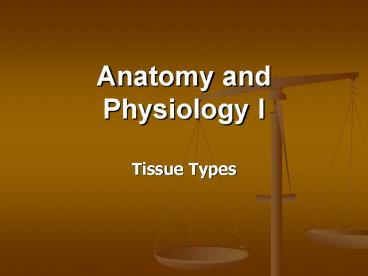Anatomy and Physiology I - PowerPoint PPT Presentation
1 / 19
Title:
Anatomy and Physiology I
Description:
Four Basic Kinds of Tissues Epithelial Tissue Connective Tissue ... Main component of the nervous system ... Bone Tree ring-like appearance Supports ... – PowerPoint PPT presentation
Number of Views:49
Avg rating:3.0/5.0
Title: Anatomy and Physiology I
1
Anatomy and Physiology I
- Tissue Types
2
Key Terms
- Histology
- the study of tissues.
- Tissues
- groups of cells which are similar in structure
and which perform common or related functions.
3
Four Basic Kinds of Tissues
- Epithelial Tissue
- Connective Tissue
- Muscle Tissue
- Nervous Tissue
4
Epithelial Tissue
- Epithelial Tissue Locations
- Covers the body
- Lines the cavities, tubes, ducts and blood
vessels inside the body - Covers the organs inside body cavities
- Epithelial Tissue Functions
- Protection from physical chemical injury,
- Protection against microbial invasion,
- Contains receptors which respond to stimuli,
- Filters, secretes reabsorbs materials and
- Secretes serous fluids to lubricate structures.
5
Connective Tissue
- Connective Tissue
- Most abundant widely distributed tissue
- Connective Tissue Functions
- Connects, binds and supports structures,
- Tendons, ligaments, etc.
- Protects cushions organs and tissues,
- Insulates (fat) and
- Transports substances (blood).
6
Muscle Tissue
- Muscle Tissue
- Associated with the bones of the skeleton, the
heart and in the walls of the hollow organs of
the body. - Muscle Tissue Functions
- Movement
- Locomotion
- Maintains posture
- Produces heat
- Facial expressions
- Pumps blood
- Peristalsis
7
Nervous Tissue
- Nervous Tissue
- Main component of the nervous system,
- ie., brain, spinal cord nerves.
- Nervous Tissue Functions
- Regulates controls body functions
- Generates transmits nerve impulses
- Supports, insulates and protects impulse
generating neurons.
8
Start Editing Here
9
- Specific tissue types representative cell types
we will review - epithelial
- Squamous
- Cuboidal
- Columnar
- connective
- Adipose
- Bone
- Hyalaine cartilage
- muscle
- nervous
10
Squamous Epithelium
- Simple one cell thick
- Forms solid layer of cells which line blood
vessels, body cavities cover organs in body
cavities
- Stratified multiple layers
- Forms epidermis
11
Cuboidal Epithelium
Cuboid Cells
- Simple one cell thick
- Roughly cube shaped
- Line ducts in kidneys, etc, where reabsorption
and secretory activities take place.
Cuboid Cells
12
Columnar Epithelium
- Simple one cell thick
- Column shaped (long narrow)
- Line digestive tract where reabsorption
secretion occurs.
- Pseudostratified gives the appearance of more
than one layer of columnar epithelial cells
13
- Specific Connective Tissue Types
- Adipose
- Bone
- Hyalaine cartilage
14
Connective - Adipose
- Honeycomb or chickenwire appearance
- Stores energy (fat)
- Insulates
- Supports protects organs
15
Connective - Bone
- Tree ring-like appearance
- Supports protects
- Mineral storage
- Fat storage
- Blood cell production
16
Connective Hyaline Cartilage
- Supports while providing flexibility
- Absorbs compression between bones in joints
(articular cartilage) - Holds open respiratory passages
- Most abundant type of cartilage in body
17
- Specific Muscle Tissue Types
- muscle (skeletal)
18
Muscle - Skeletal
- Muscle fibers (cells) long, parallel
cylindrical - With many nuclei (multinucleate)
- Striations (cross stripes run perpendicular to
the cells - Produce voluntary movement
- Locomotion
- Heat
19
Specific Nervous Tissue Types Nervous
Neuron
- Branching cells with many long processes
- Large central nucleus
- Transmit impulses from one area of the body to
other areas - Regulate activities through neuron impulses































